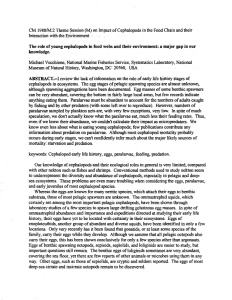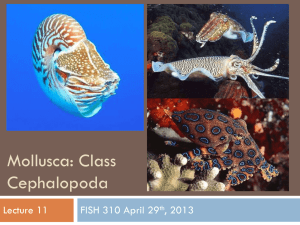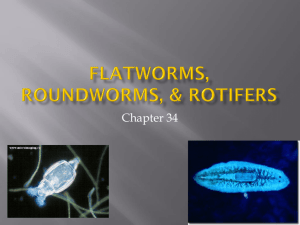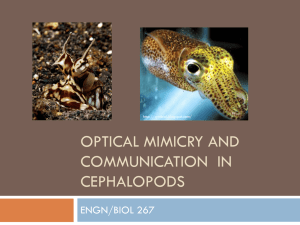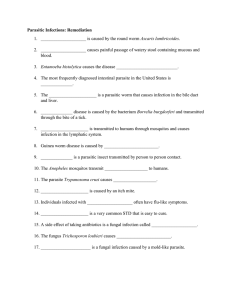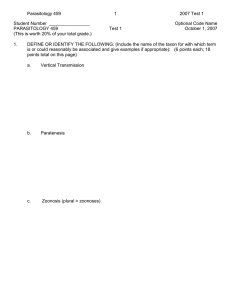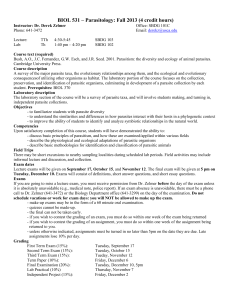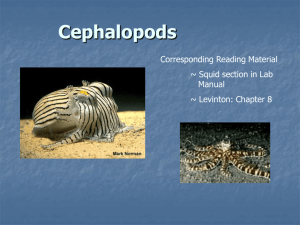WHAT PARASITES? THE CEPHALOPOD A SUITABLE HOST FOR OF GALICIAN WATERS
advertisement
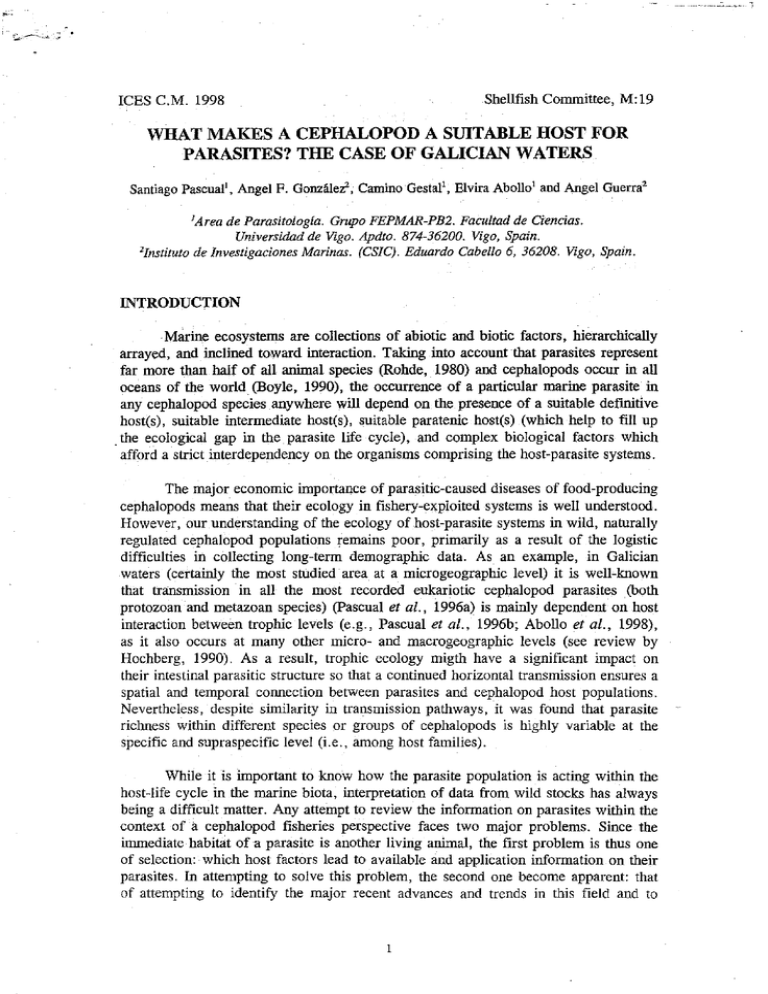
",", .. Shellfish Committee, M:19 ICES C.M. 1998 WHAT MAKES A CEPHALOPOD A SUITABLE HOST FOR PARASITES? THE CASE OF GALICIAN WATERS Santiago Pascual', Angel F. GonzaleZ', Camino Gestal', Elvira Abollo' and Angel Guerra2 lArea de Parasitologia. Grupo FEPMAR-PB2. Facultad de Ciencias. Universidad de Vigo. Apdto. 874-36200. Vigo, Spain. lInstituto de Investigaciones Marinas. (CSlC). Eduardo Cabello 6, 36208. Vigo, Spain. INTRODUCTION Marine ecosystems are collections of abiotic and biotic factors, hierarchically arrayed, and inclined toward interaction. Taking into account that parasites represent far more than half of all animal species (Rohde, 1980) and cephalopods occur in all oceans of the world (Boyle, 1990), the occurrence of a particular marine parasite in any cephalopod species anywhere will depend on the presence of a suitable defInitive host(s), suitable intermediate host(s), suitable paratenic host(s) (which help to fill up . the ecological gap in the parasite life cycle), and complex biological factors which afford a strict interdependency on the organisms comprising the host-parasite systems. The major economic importance of parasitic-caused diseases of food-producing cephalopods means that their ecology in fishery-exploited systems is well understood. However, our understanding of the ecology of host-parasite systems in wild, naturally regulated cephalopod populations remains poor, primarily as a result of the logistic difficulties in collecting long-term demographic data. As an example, in Galician waters (certainly the most studied area at a microgeographic level) it is well-known that transmission in all the most recorded eukariotic cephalopod parasites (both protozoan and metazoan species) (Pascual et al., 1996a) is mainly dependent on host interaction between trophic levels (e.g., Pascual et at., 1996b; Abollo et al., 1998), as it also occurs at many other micro- and macrogeographic levels (see review by Hochberg, 1990). As a result, trophic ecology migth have a significant impact on their intestinal parasitic structure so that a continued horizontal transmission ensures a spatial and temporal connection between parasites and cephalopod host popUlations. Nevertheless, despite similarity in transmission pathways, it was found that parasite richness within different species or groups of cephalopods is highly variable at the specific and supraspecific level (i.e., among host families). While it is important to know how the parasite population is acting within the host-life cycle in the marine biota, interpretation of data from wild stocks has always being a difficult matter. Any attempt to review the information on parasites within the context of a cephalopod fisheries perspective faces two major problems. Since the immediate habitat of a parasite is another living animal, the first problem is thus one of selection: which host factors lead to available and application information on their parasites. In attempting to solve this problem, the second one become apparent: that of attempting to identify the major recent advances and trends in this field and to 1 place them in a context of a development of the conceptual framework into which new data should be fitted, and in the light of which existing information could be reinterpreted. To this end, this contribution examines the ecological background of hostparasite interactions at the Galician waters. Particular emphasis was placed on lifehistory ecological characteristics of cephalopods and how such host external factors can affect parasite richness. MATERIALS AND METHODS Host and parasite databases (available to author's request) were made on the published parasitological (see review by Pascual et al., CIESM Banyuls 1996) and cephalopod life history (ICES C.M. 1994/K:7 Report of the Study Group on the Life History and Assessment of Cephalopods, Cork 1993) analysis of more than 2,000 specimens belonging to 10 cephalopod species which were collected during 1992-1998 from the local fishing grounds off the Galician coast (42°5'-45°15' N,7°-9°20'W) (Fig. 1); Taxonomic identification of the parasitefauna was done to the species· or genus level according to standard protocols (pascual, 1996) what is considered to be 'adequately' to reveal potential general relationships between parasitic disease risk [expressions of parasite richness such as RSD, relative species diversity; M/H, monoxenous (those with direct life cycle)/heteroxenous (those with indirect life cycle) ratio; and S/G, specialist (those with narrow host specificity able to survive on a single host species)/generalist (those with wide host specificity able to survive on a wide range of host species in a heterogeneous community) ratio] and eight features of cephalopod data on life-hystory, environmental factors and fisheries [depth (DRP, DRJA) , temperature (TRJA) and salinity (SRJA) ranges, exploitation level (EL), potential fecundity (PF), maximum mantle length at full maturity (MMLFM) , bathymetry (B) and vagility (migration scale, MS)]. Moreover, an index of similarity (PSC) (Krebs, 1978) was used to compare parasitic species overlap between the various cephalopod species. RESULTS No significant differences was. found inRSD values between interspecific cephalopods in relation to environmental factors (depth, temperature and salinity) (Fig.2). However, the M/H and S/G ratios are lower at those juvenil and adult cephalopod animals with higher depth range. Moreover, parasitic species richness was different in relation to life history characteristics of cephalopods. M/H and S/G ratios were higher corresponding with higher RSD values as mantle length increased. The M/H ratio was also higher at those cephalopod species with high level of exploitation, and both M/H and S/G ratios were higher at lower MS values. Finally, PSC values (Table 1) showed that a parasitic species overlap largely occur between certain cephalopod species inhabiting the same ecological niche, revealing two parasitocoenoses, coastal and nerito-oceanic (Fig. 3). 2 ~.-- • -~ • 9"W sow (9) Sepia orbignyana (10) Sepia e/egans Fig. 1. Sampling area and cephalopod species examined. 3 I.z.;,;.--"\' -- _M1H Il!!ISIG .,RSO DRP(m) _MlH IIiSIG ·eRSO _MlH I'IISIG BRSD SRJA (%~ _M1H .S/G aRSO _MlH .SIG aRSO DRJA(m) .MlH &I!IS/G ~!RSD EL 200 222 260 380 400 500 2 MMLFM(mm) 3 4 B(m) 5 6 _MlH EaS/G .. RSO 30-50 <200 MS(Km) Fig. 2. Relationships between parasitic richness (M/H, S/G and RSD) and ICES-data on environmental factors, fisheries and life-history characteristics of cephalopods at the sampling area. (DRP, depth range of paralarvae; DRJA, depth range of juveniles/adults; PF expressed the number of eggs). Table 1.- PSC (%) values used to compare parasitic species overlap between the various cephalopod species. (1 ) (2) (3) (4) (5) (6) (7) (8) (9) (10) (1 ) 0.25 0.66 0.67 0.60 0.60 0.36 0.66 0.80 OAO T. sagittatus 0.28 0.25 0.50 0.22 0.28 0.66 0.66 (4) OAO 0.66 0.36 0.44 OAO 0.00 0.61 0.66 0.43 0.50 0.50 0.12 T. eblanae I. coindetii (5) 0.60 (6) E. cirrhosa 0.40 0.54 (7) O. vulgaris OA6 0.67 0.43 (8) S. officinalis 0.44 0.80 0040 0.50 (9) S. orbignyana 0.22 0040 0.20 0040 0.50 (10) S. elegans 4 <~---- DISCUSSION All the above results, clearly suggests that environmental and fisheries characteristics of cephalopods do not appear as important determinants of eukariotic parasite richness and parasitic disease risk. However, ecological and behavioural features on the cephalopod life cycle [mode.of life (benthic, pelagic, nektonic; coastal, neritic, oceanic), displacements (sedentary, migratory), behaviour (solitary or gregarious)] appear to be extremely important as a determinant of parasitic disease risk in terms of parasitic richness and species diversity. Except for mesozoan and coccidian parasites (which life cycles should yet be examined in detail), cephalopods are primary intermediate or paratenic hosts (i.e., they host parasitic larval forms with low host specificity) which may well explain the above results. (10) Sepia eiegans Fig. 3. Grouping of cephalopod species with similar parasitic disease risk. If we consider the external environment, the environment of the second order for parasites (i.e., the macroenvironment, Pavlovsky, 1934), as the medium of life for parasites and their hosts, we must look at the endemiotope as a whole with the multiplicity of on-going processes within. If so, our results clearly confirm the link between cephalopod ecological segregation and parasite richness. Partial overlaps in parasitic species richness among cephalopod species could indicate temporary breakdowns in food/habitat segregation, as well as reflecting that segregation is less pronounced between the same size-age host classes than between ontogenetic intraspecific groups. Nevertheless, it also should be noted that cephalopod life-history characteristics (from coloration to growth rate) are to a unknown extent under 5 .. environmental influence and are not inherited in a simple Mendelian fashion (Pierce et al., 1994). The final conclusion was that similarity of spatial and trophic aspects of the ecological niches of cephalopods (i.e., their ecological valence) had a predominant and greater influence on the eukariotic parasitic pattemsthan do a multiplicity of local abiotic factors promoting distinctiveness (Fraga et al., 1992). It follows from the foregoing considerations that differences in parasite richness are due, in the final count, to fluctuations in the ecological conditions of the biotopes (that means in the vertical and horizontal structure of ecosystems) which inhabit the different cephalopod species. The present results do fully .agree with Russian authors which gave an extensive discussion on the ecological relationships of the host-parasite systems for various squid species of the family Ommastrephidae in the Atlantic Ocean (Gaevskaya, 1977; Gaevskaya .&Nigmatullin, 1975, 1977, 1978, 1983; Nigmatullin & Shukhgalter, 1990; Bagrov, 1982; Gaevskaya et aI., 1986, 1987). Theysuggested the existence of two helminthocoenoses (coastal and oceanic) with different parasitic species composition and with cosmopolitan forms within both parasitocoenoses. Assuming that cephalopod species .which are ecological equivalents are subjected to a same degree of parasitic disease risk, we could extrapolate the parasitic . infection results on a single cephalopod species at any geographic locality to each ecologically-characterised cephalopod-parasite system. This reduces, therefore, the problems associated with the development of complex epidemiological evaluation models which, without laborious and time-consuming information on the different host-parasite systems at the supracommunity level, could be rather speculative. In the future, it is obvious that infected cephalopod natural stocks should be modelled by using mathematical models which will require an holistic examination of the parasitocoenoses within parasite communities at different hierarchically levels. Then, since the habitat of a cephalopod species is more important in determining its parasitic community richness than is cephalopod phylogeny (that is to say, because the parasitic diseases risk may be interpreted as a function of cephalopod biology), this information could be used to help managing of heavily infected cephalopod fisheries in the next years. ACKNOWLEDGEMENTS This study was funded by the Spanish Project CICYTMAR95-1919-C05 and Xunta de Galicia under Project XUGA3011 OA-97 . 6 LITERATURE CITED Abollo, E, Gestal, c., L6pez, A" Gonzalez, A,F" Guerra, A" Pascual, S, 1998, Squids as 'trophic bridges' for parasite flow within marine ecosystems: the case of Anisakis simplex or when the wrong way can be right. South African Journal of Marine Science, in press, Bagrov, A, A, 1982, On the infectation rate of squids of the North Pacific by anisakid larvae (Nematoda, Anisakidae), Parasitologiya, XVI (3): 200-203, Boyle, p, R 1990, Cephalopod biology in fisheries context. Fisheries Research, 8: 303-321. Fraga, F., Maurino, C., Manriquez. M. 1982. Las masas de agua en las costas de Galicia: juniooctubre, Resultados de Expediciones Cient(ficas, 10: 51-77, Gaevskaya, A, V, 1977, Helminthofauna of the Atlantic squid Sthenoteuthis pteropus (Streentrup), Sci. Rep, Riger School" Biological Science, 8: 47-52 (in Russian), Gaevskaya, A" Nigmatullin, Ch, M, 1975, The helminthofauna of Atlantic squids of the familly Ommastrephidae (Cephalopoda: Oegopsida) in relation to features of their ecology, In: Molluscs: their systematics, evolution and role in nature, V Malacological Congress, Izdvo, nauta, Leningrad: 168-171 (in Russian), Gaevskaya, A., Nigmatullin, Ch. M. 1977. Distribution of the metacercariae of didymozoid trematodes among Atlantic squids of the family Ommastrephidae. In: All-Union Scientific Conference on the Utilization of Commercial Invertebrates for Food, Fodder, and Technological Purposes, Odessa: 20-22, (in Russian). Gaevskaya, A., Nigmatullin, Ch, M. 1978. The helminth fauna of the Atlantic squids of the family Ommastrephidae (Cephalopoda: Oegopsida). Malacological Reviews, 11: 134-135. Gaevskaya, A., Nigmatullin, Ch. M. 1983. Ecological aspects of age variability of the helminthofauna of squids of the family Ommastrephidae. In: Conference on the Biological Bases of the Control of Helminth Animals and Plants. Abstracts of Reports, Moscow: 19-21. Gaevskaya, A., Nigmatullin, Ch, M" Shukhgalter, O. A., 1986, Comparative ecological characteristics of the parasitofauna of common species od squid of the family Ommastrephidae in the southwestern Atlantic. In: Parasitology and Pathology of Marine Organisms. Abstracts of Proceedings of the 4th All-Union Conference on Commercial Invertebrates, Sevastopol: 337-338 (in Russian), Gaevskaya, A., Nigmatullin, Ch, M" Shukhgalter, 0, A., 1987, Geographical variability of the ontogenetic dynamics of helminth infestation in the squid Disidicus gigas in the central eastren Pacific .. In: Parasitology and Pathology of Marine Organisms, Abstracts of Proceedings of the 4th All-Union Symposium, Kalinigrad: 23-25 (in Russian), Hochberg. F. G. 1990. Diseases of Mollusca: Cephalopoda, In: Diseases of Marine Animals: Cephalopoda to Urochordata, vol., III. Kinne, (Ed,). Biologisches Anstalt Helgoland, Hamburg: 47-227. Krebs, C. J, 1978. Ecology. The experimental analysis of distribution and abundance. 2nd edition. Haper &Row, New York, 678 pp. Nigmatullin, Ch, M., Shukhgalter, 0, A., 1990, Helmintofauna y aspectos ecologicos de las relaciones parasitarias del calamar (Ill ex argentinus) en el Atlantico Sudoccidental. Frente Marftimo, Vol. 7, Sec, A: 57-68, Pascual. S. 1996. Los Sitemas Hospedador-Parasito en las Pesquerfas de Ommastrifidos de Galicia. Ph, D Thesis. University of Vigo, Spain, 167 pp. Pascual. S., Gestal. c., Guerra, A. 1996, Report of Research on Cephalopod Parasites. CIESMWorkshop on Cephalopod Parasites, Banyuls.sur-Mer, France (28-31 October), II pp, Pascual. S., Gestal. c., Estevez, J" Rodriguez, H., Soto, M" Abollo, E., Arias, C. 1996a, Parasites in commercially-exploited cephalopods in Spain: and updated perspective. Aquaculture. 142: 1-10, Pascual. S" Gonzalez, A. E, Arias, c., Guerra, A, 1996b, Biotic relationships of Illex coindetii and Todaropsis eblanae (Cephalopoda, Ommastrephidac) in the Northeast Atlantic: evidences from parasites. Sarsia, 81: 265-274, Pavlosky, E. W. 1934. Organisms as environment. Priuda, Mosva-I: 80-91. Pierce, G, J" Thorpe, R. S., Hastie, L. c., Brierley, A. S., Guerra, A., Boyle, p, R, Jamieson, R" Avila, p" 1994, Geographic vasnation in Loligo forbesi in the Northeast Atlantic ocean: analysis of morphometric data and test of causal hypoteses, Marine Biology, 119: 541-547. Rhode, K. 1980. Diversity gradients of marine Monogena in the Atlantic and Pacific Oceans, Experelllia, 36: 1368-1369, ° 7

